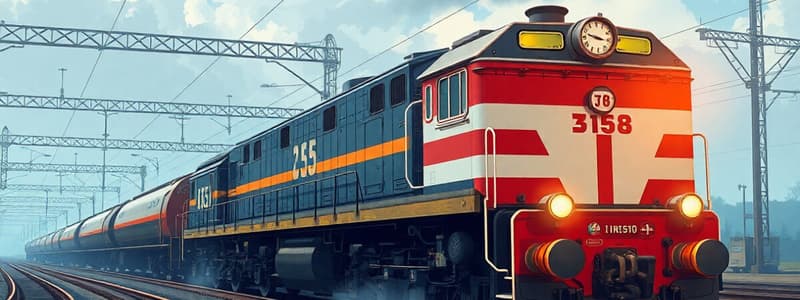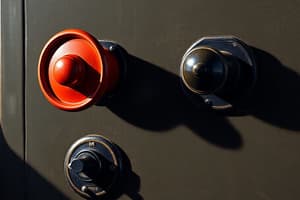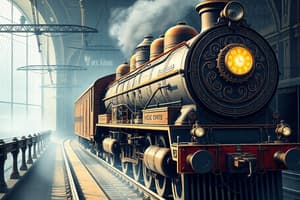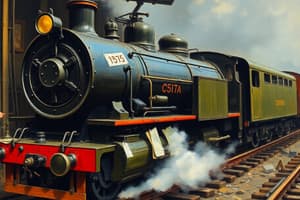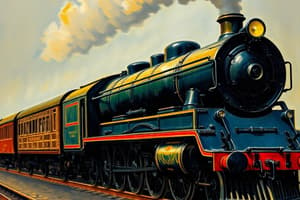Podcast
Questions and Answers
What should a driver check regarding the traction motor if it has been isolated during the previous run?
What should a driver check regarding the traction motor if it has been isolated during the previous run?
- The position of the isolating switch for that motor (correct)
- The pressure in the air reservoir
- The battery charger generator status
- The condition of the hand brake
What is the required air pressure for the vacuum brake system to be considered effective?
What is the required air pressure for the vacuum brake system to be considered effective?
- 25 cm
- 53 cm (correct)
- 30 cm
- 40 cm
What should happen when the air blast circuit breaker is closed?
What should happen when the air blast circuit breaker is closed?
- The main compressor should switch off
- The auxiliary machines should start (correct)
- The indication lamps should remain illuminated
- The vacuum rail should increase pressure
After applying the independent air brakes, what should be examined to verify effectiveness?
After applying the independent air brakes, what should be examined to verify effectiveness?
What is the main purpose of using the battery-operated compressor?
What is the main purpose of using the battery-operated compressor?
What is one responsibility of the Assistant Driver during the run of the train?
What is one responsibility of the Assistant Driver during the run of the train?
What must the Assistant Driver maintain while on duty?
What must the Assistant Driver maintain while on duty?
What governs the trailing loads assigned to various types and classes of locomotives?
What governs the trailing loads assigned to various types and classes of locomotives?
Which responsibility is specifically assigned to the Co-driver during high speed train operations?
Which responsibility is specifically assigned to the Co-driver during high speed train operations?
What must be carried out before fixing the loads for a specific class of locomotive?
What must be carried out before fixing the loads for a specific class of locomotive?
When taking over a locomotive, which is NOT a responsibility of the Driver?
When taking over a locomotive, which is NOT a responsibility of the Driver?
Why might loads for multiple operations not be exact multiples of loads with a single locomotive?
Why might loads for multiple operations not be exact multiples of loads with a single locomotive?
Which of the following tasks is NOT the responsibility of the Assistant Driver?
Which of the following tasks is NOT the responsibility of the Assistant Driver?
Who is responsible for ensuring the cleanliness of the interior of the locomotive?
Who is responsible for ensuring the cleanliness of the interior of the locomotive?
Which individuals are permitted to enter the driving compartments of a locomotive?
Which individuals are permitted to enter the driving compartments of a locomotive?
Who is responsible for fixing the loads for each section for each class of locomotive?
Who is responsible for fixing the loads for each section for each class of locomotive?
What should the Assistant Driver do if the train stops for more than 15 minutes?
What should the Assistant Driver do if the train stops for more than 15 minutes?
What should a driver focus on while on the run?
What should a driver focus on while on the run?
What additional duty may the Assistant Driver perform as instructed?
What additional duty may the Assistant Driver perform as instructed?
What is the main goal of preparing loco link diagrams?
What is the main goal of preparing loco link diagrams?
What should the Assistant Driver maintain regarding detentions enroute?
What should the Assistant Driver maintain regarding detentions enroute?
How is the running staff for mail, express, and passenger services prepared?
How is the running staff for mail, express, and passenger services prepared?
What is prohibited regarding measuring instruments and protective relays?
What is prohibited regarding measuring instruments and protective relays?
What factors may affect the actual load that can be hauled by a locomotive?
What factors may affect the actual load that can be hauled by a locomotive?
Which item is specifically mentioned as needing cleanliness checks by the Assistant Driver?
Which item is specifically mentioned as needing cleanliness checks by the Assistant Driver?
What must be done if a driver opens a sealed relay?
What must be done if a driver opens a sealed relay?
What should an Assistant Driver specifically watch while on the run?
What should an Assistant Driver specifically watch while on the run?
Which of the following activities is NOT permitted for a driver off duty?
Which of the following activities is NOT permitted for a driver off duty?
What is the primary concern of a driver during operation?
What is the primary concern of a driver during operation?
What should be done with oil drippings found inside the locomotive?
What should be done with oil drippings found inside the locomotive?
Which of the following conditions require immediate action from maintenance staff?
Which of the following conditions require immediate action from maintenance staff?
What must a Driver do before signing off the loco log book?
What must a Driver do before signing off the loco log book?
What is a requirement for a Driver to work a train in a section?
What is a requirement for a Driver to work a train in a section?
How long must a Driver be absent before needing revalidation of their Certificate of Competence?
How long must a Driver be absent before needing revalidation of their Certificate of Competence?
What additional action is taken when a locomotive is stabled on a pit line?
What additional action is taken when a locomotive is stabled on a pit line?
What must a Driver do after learning the road in their section?
What must a Driver do after learning the road in their section?
What is the purpose of the Road Knowledge Register?
What is the purpose of the Road Knowledge Register?
What can happen if a Driver has not worked on a section for an extended period?
What can happen if a Driver has not worked on a section for an extended period?
What should be included in the loco log book besides the kilometre reading?
What should be included in the loco log book besides the kilometre reading?
What action is required if a Driver, Assistant Driver, or Shunter has been absent for six months?
What action is required if a Driver, Assistant Driver, or Shunter has been absent for six months?
What should a Driver sign after learning the road?
What should a Driver sign after learning the road?
Which of the following statements about the cleanliness of locomotives is true?
Which of the following statements about the cleanliness of locomotives is true?
What is the maximum number of persons allowed to travel in the cab of a locomotive, excluding running staff?
What is the maximum number of persons allowed to travel in the cab of a locomotive, excluding running staff?
What action must be taken by a driver if they open a sealed relay?
What action must be taken by a driver if they open a sealed relay?
During operations, which instruments must the assistant driver monitor closely?
During operations, which instruments must the assistant driver monitor closely?
Which of these activities is forbidden for a driver who is off duty?
Which of these activities is forbidden for a driver who is off duty?
What is necessary to avoid when putting back metallic covers of relays?
What is necessary to avoid when putting back metallic covers of relays?
Who is responsible for ensuring that unauthorized persons do not enter the locomotive compartments?
Who is responsible for ensuring that unauthorized persons do not enter the locomotive compartments?
What should be done if the white lamp or the corresponding LED for rectifier indicates a fault during the testing process?
What should be done if the white lamp or the corresponding LED for rectifier indicates a fault during the testing process?
What is the sequence of actions when conducting a vacuum check before starting?
What is the sequence of actions when conducting a vacuum check before starting?
During a quick inspection of mechanical parts, which element's condition should signal immediate attention for potential issues?
During a quick inspection of mechanical parts, which element's condition should signal immediate attention for potential issues?
What should a driver do regarding isolating cocks of the brake in the rear cab before operating the locomotive?
What should a driver do regarding isolating cocks of the brake in the rear cab before operating the locomotive?
Which of the following is a critical step before raising the pantographs for operation?
Which of the following is a critical step before raising the pantographs for operation?
What must a Driver do in the event of being absent from duty for six months?
What must a Driver do in the event of being absent from duty for six months?
In addition to the kilometre reading, what unusual occurrences must be included in the loco log book?
In addition to the kilometre reading, what unusual occurrences must be included in the loco log book?
What specific tasks are required of the Driver during the inspection of a locomotive on a pit line?
What specific tasks are required of the Driver during the inspection of a locomotive on a pit line?
Which of the following is NOT a requirement for a Driver before working a train in a new section?
Which of the following is NOT a requirement for a Driver before working a train in a new section?
What regulation governs the creation of Road Knowledge Registers for train staff?
What regulation governs the creation of Road Knowledge Registers for train staff?
Upon completion of road training, who is responsible for verifying the competency of the Driver?
Upon completion of road training, who is responsible for verifying the competency of the Driver?
What happens if a Driver has been absent but had no chance to work on the section?
What happens if a Driver has been absent but had no chance to work on the section?
Which of the following statements about the loco log book is accurate?
Which of the following statements about the loco log book is accurate?
What is the key purpose of maintaining a Road Knowledge Register?
What is the key purpose of maintaining a Road Knowledge Register?
Which item must be checked for normal position during the energization of the control circuit?
Which item must be checked for normal position during the energization of the control circuit?
What should be done if a relay target indicates red during the checks?
What should be done if a relay target indicates red during the checks?
Which condition is necessary for fuses in the fuse rack during the control circuit check?
Which condition is necessary for fuses in the fuse rack during the control circuit check?
What is necessary to check regarding the air blast circuit breaker during the preliminary check?
What is necessary to check regarding the air blast circuit breaker during the preliminary check?
What should be monitored in the driver's vacuum brake handle during checks?
What should be monitored in the driver's vacuum brake handle during checks?
Which indicator lamp color is associated with the tap changer during the control circuit check?
Which indicator lamp color is associated with the tap changer during the control circuit check?
What is the correct action regarding the auxiliary isolating switches?
What is the correct action regarding the auxiliary isolating switches?
During the preliminary check, which item is specifically mentioned regarding oil levels?
During the preliminary check, which item is specifically mentioned regarding oil levels?
What is the significance of the indicator lamps during the energization of the control circuit?
What is the significance of the indicator lamps during the energization of the control circuit?
What is required regarding the condition of the air reservoir drain cocks during preliminary checks?
What is required regarding the condition of the air reservoir drain cocks during preliminary checks?
What must Drivers and Assistant Drivers be fully conversant with regarding speed restrictions?
What must Drivers and Assistant Drivers be fully conversant with regarding speed restrictions?
What is required from Drivers concerning the 'Temporary Speed Restrictions' bulletin?
What is required from Drivers concerning the 'Temporary Speed Restrictions' bulletin?
What is the primary function of the loco log book?
What is the primary function of the loco log book?
How should the loco keys be handled according to the content provided?
How should the loco keys be handled according to the content provided?
What should be done with the loco log book when a Driver signs off?
What should be done with the loco log book when a Driver signs off?
What type of equipment is a portable telephone considered for the Driver?
What type of equipment is a portable telephone considered for the Driver?
Which aspect of speed restrictions is specifically detailed in the working time table?
Which aspect of speed restrictions is specifically detailed in the working time table?
What is indicated by the machine numbered pages in the loco log book?
What is indicated by the machine numbered pages in the loco log book?
Why must a Driver be revalidated to operate a train in a section after an extended absence?
Why must a Driver be revalidated to operate a train in a section after an extended absence?
What is one responsibility of the Driver when taking over a loco?
What is one responsibility of the Driver when taking over a loco?
Flashcards
Trailing Loads
Trailing Loads
The maximum load a locomotive can pull on a specific track, considering various factors like track condition, gradient, curves, and driver ability.
Load Chart
Load Chart
A document from RDSO used to determine assigned trailing loads for different locomotive types.
Multiple Operation Trials
Multiple Operation Trials
Tests conducted to establish the combined load capacity of multiple locomotives working together.
Loco Link Diagrams
Loco Link Diagrams
Signup and view all the flashcards
Operating Staff Assessment
Operating Staff Assessment
Signup and view all the flashcards
Time Tabling
Time Tabling
Signup and view all the flashcards
Section-wise Loading
Section-wise Loading
Signup and view all the flashcards
Actual Site Conditions
Actual Site Conditions
Signup and view all the flashcards
Theoretical Site Conditions
Theoretical Site Conditions
Signup and view all the flashcards
Loco Cleanliness
Loco Cleanliness
Signup and view all the flashcards
Unauthorised Loco Entry
Unauthorised Loco Entry
Signup and view all the flashcards
Driver's Role - Cab
Driver's Role - Cab
Signup and view all the flashcards
Driver's Duty - Off Duty
Driver's Duty - Off Duty
Signup and view all the flashcards
Equipment Tampering
Equipment Tampering
Signup and view all the flashcards
Equipment Maintenance
Equipment Maintenance
Signup and view all the flashcards
Driver's Run Checks
Driver's Run Checks
Signup and view all the flashcards
Assistant Driver's Run Checks
Assistant Driver's Run Checks
Signup and view all the flashcards
Assistant Driver Duties
Assistant Driver Duties
Signup and view all the flashcards
Driver Checks on Taking Over
Driver Checks on Taking Over
Signup and view all the flashcards
Locomotive Cleanliness
Locomotive Cleanliness
Signup and view all the flashcards
Signal Exchange
Signal Exchange
Signup and view all the flashcards
High Speed Train Assistant
High Speed Train Assistant
Signup and view all the flashcards
Equipment Checks (Assistant Driver)
Equipment Checks (Assistant Driver)
Signup and view all the flashcards
Reporting Irregularities
Reporting Irregularities
Signup and view all the flashcards
Maintaining a Log
Maintaining a Log
Signup and view all the flashcards
Draining Cocks
Draining Cocks
Signup and view all the flashcards
Loco Log Book
Loco Log Book
Signup and view all the flashcards
TFR/ATFR's Office
TFR/ATFR's Office
Signup and view all the flashcards
Pit Line
Pit Line
Signup and view all the flashcards
Under-gear & Roof Inspection
Under-gear & Roof Inspection
Signup and view all the flashcards
Road Knowledge
Road Knowledge
Signup and view all the flashcards
Certificate of Competence
Certificate of Competence
Signup and view all the flashcards
Six-Month Absence
Six-Month Absence
Signup and view all the flashcards
Pilot Driver
Pilot Driver
Signup and view all the flashcards
Road Knowledge Registers
Road Knowledge Registers
Signup and view all the flashcards
Loco Log Book Check
Loco Log Book Check
Signup and view all the flashcards
Traction Motor Cut-Out
Traction Motor Cut-Out
Signup and view all the flashcards
Compressed Air Check
Compressed Air Check
Signup and view all the flashcards
Circuit Breaker Closure
Circuit Breaker Closure
Signup and view all the flashcards
Exhauster Start-Up
Exhauster Start-Up
Signup and view all the flashcards
Hand Brake Test
Hand Brake Test
Signup and view all the flashcards
Air Brake Test
Air Brake Test
Signup and view all the flashcards
Vacuum/Air Brake Test
Vacuum/Air Brake Test
Signup and view all the flashcards
Traction Motor Blowers
Traction Motor Blowers
Signup and view all the flashcards
Loco Cleanliness
Loco Cleanliness
Signup and view all the flashcards
Unauthorised Loco Entry
Unauthorised Loco Entry
Signup and view all the flashcards
Driver's Role - Cab
Driver's Role - Cab
Signup and view all the flashcards
Driver's Duty - Off Duty
Driver's Duty - Off Duty
Signup and view all the flashcards
Equipment Tampering
Equipment Tampering
Signup and view all the flashcards
Equipment Maintenance
Equipment Maintenance
Signup and view all the flashcards
Driver's Run Checks
Driver's Run Checks
Signup and view all the flashcards
Assistant Driver's Run Checks
Assistant Driver's Run Checks
Signup and view all the flashcards
Speed Restrictions
Speed Restrictions
Signup and view all the flashcards
Loco Log Book
Loco Log Book
Signup and view all the flashcards
TFR/ATFR's Office
TFR/ATFR's Office
Signup and view all the flashcards
Loco Log Book
Loco Log Book
Signup and view all the flashcards
Pit Line
Pit Line
Signup and view all the flashcards
Temporary Speed Restrictions
Temporary Speed Restrictions
Signup and view all the flashcards
Permanent Speed Restrictions
Permanent Speed Restrictions
Signup and view all the flashcards
Under-gear & Roof Inspection
Under-gear & Roof Inspection
Signup and view all the flashcards
Road Knowledge
Road Knowledge
Signup and view all the flashcards
Certificate of Competence
Certificate of Competence
Signup and view all the flashcards
Six-Month Absence
Six-Month Absence
Signup and view all the flashcards
Pilot Driver
Pilot Driver
Signup and view all the flashcards
Road Knowledge Registers
Road Knowledge Registers
Signup and view all the flashcards
Loco Log Book Check
Loco Log Book Check
Signup and view all the flashcards
Reverser Position
Reverser Position
Signup and view all the flashcards
Yellow Lamp Off
Yellow Lamp Off
Signup and view all the flashcards
White Lamp/Rectifier
White Lamp/Rectifier
Signup and view all the flashcards
Traction Motor Ammeter
Traction Motor Ammeter
Signup and view all the flashcards
Tap Changer Lamp
Tap Changer Lamp
Signup and view all the flashcards
Pantograph Test
Pantograph Test
Signup and view all the flashcards
Sanders Operation
Sanders Operation
Signup and view all the flashcards
Marker/Headlights/Flasher
Marker/Headlights/Flasher
Signup and view all the flashcards
Vacuum Check
Vacuum Check
Signup and view all the flashcards
Minimum Vacuum
Minimum Vacuum
Signup and view all the flashcards
Loco Stability Check
Loco Stability Check
Signup and view all the flashcards
Electrical Coupler Tightness
Electrical Coupler Tightness
Signup and view all the flashcards
Control Circuit Energization
Control Circuit Energization
Signup and view all the flashcards
Battery Voltage Check
Battery Voltage Check
Signup and view all the flashcards
Auxiliary Switch Indication Lamps
Auxiliary Switch Indication Lamps
Signup and view all the flashcards
Fuse and Breaker Check
Fuse and Breaker Check
Signup and view all the flashcards
Earthing Switch Check
Earthing Switch Check
Signup and view all the flashcards
Tap Changer and Transformer Oil Level
Tap Changer and Transformer Oil Level
Signup and view all the flashcards
Auxiliary Isolation Switches
Auxiliary Isolation Switches
Signup and view all the flashcards
Air Blast Circuit Breaker & Pantograph Drain Cocks
Air Blast Circuit Breaker & Pantograph Drain Cocks
Signup and view all the flashcards
Tap Changer Isolating Switch
Tap Changer Isolating Switch
Signup and view all the flashcards
Earth Fault Isolating Switches
Earth Fault Isolating Switches
Signup and view all the flashcards
Pressure Relay for Main Circuit Breaker
Pressure Relay for Main Circuit Breaker
Signup and view all the flashcards
Relay Target Indication
Relay Target Indication
Signup and view all the flashcards
Rectifier Block Isolating Switches
Rectifier Block Isolating Switches
Signup and view all the flashcards
Cab Control Position Check
Cab Control Position Check
Signup and view all the flashcards
Compressor and Exhauster Oil Levels
Compressor and Exhauster Oil Levels
Signup and view all the flashcards
Study Notes
Operation of Locomotives
- Trailing loads assigned to locomotives are governed by RDSO load charts (Annexure 1.03).
- Loads are calculated considering theoretical site conditions and track geometry.
- Actual site conditions and track geometry may differ.
- Partial brake binding, driver capabilities, and weather can affect the actual load hauled.
- Trials with actual sections and loads should be conducted to verify locomotive capabilities on specific sections.
- Multiple locomotive operations require separate trials for different numbers of locomotives (2, 3, or 4).
- Load distribution between locomotives may not be equal due to manufacturing tolerances and varying wheel diameters.
- Nominated loads (single and multiple) for each section and loco class should be determined and tabulated.
- Loads for each section and locomotive class should be determined by CEE in consultation with COM.
Time Tabling and Loco Link Diagrams
- Loco link diagrams are prepared to maximize locomotive utilization by minimizing downtime at terminals.
- Close coordination between senior DOM/DOM and senior DEE(OP)/DEE(OP) is necessary.
Assessment of Operating Staff for Electric Locos
- Running staff requirements are determined based on timetables and minimum rest periods.
- Staff requirements for Rajdhani/Shatabdi and other high-speed trains are adjusted due to co-driver responsibilities.
- Assessment considers the "turn-round" method, encompassing "signing-on time" and "signing-off time" plus waiting duty.
- Average driver turn-around time includes journey time.
Duties of Electric Loco Drivers
- Drivers must inspect the locomotive logs and inspect for abnormalities.
- Drivers must pay close attention to overhead lines.
- While examining the undercarriage, maintain brakes in the "ON" position.
- No unauthorized personnel are allowed in the cab (except authorized supervisors or staff by written order).
- Drivers are responsible for locomotive cleanliness.
- Special checks are required if the halt duration exceeds 10 minutes.
- Report any abnormalities during operations and submit reports.
Knowledge of Road
- Drivers and assistants need thorough knowledge of assigned sections (maximum speeds, gradients, land marks, signals, etc.).
- If drivers are absent for six months, read the road again (or the time period may be adjusted by local instructions).
- Road Knowledge Registers (separate for each section, each staff category) are maintained, following a specific format.
Driver's Personal Equipment
- Drivers are expected to have specific tools (log book, operating manual, rules book, watch, wrenches, torch, flags etc.)
Personal Effects of Assistant Driver
- Assistant drivers are expected to have specific tools (flags, journals, watches, etc.).
Operation of Air Braked Stock
- Operation details for Air Braked stocks
- Procedures for checking leakage rate of the air brake system, with and without auxiliaries.
- Instructions on operating and maintaining air-braked stock.
Master Controller
- Master controller operation (stable/unstable positions) for traction and braking is explained.
Starting of a Train
- Two-stage initial starting and acceleration is outlined, for both down and up gradients.
Speed Control
- Speed regulation when current falls below rated values; including field weakening.
Neutral Sections
- Crucial information on switching off power when passing through neutral sections are provided, including specific signage.
Double Heading
- Procedures for operating trains with two locomotives.
- Maximum speed limitations for double headed operation.
Heavy Haul Trains
- Procedures and instructions for operating trains classified as Heavy Haul.
Various other procedures and operations
Studying That Suits You
Use AI to generate personalized quizzes and flashcards to suit your learning preferences.
